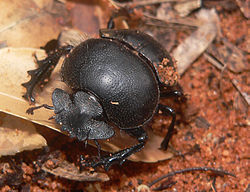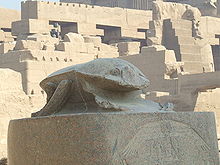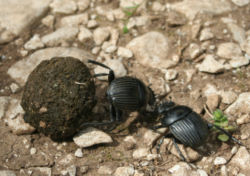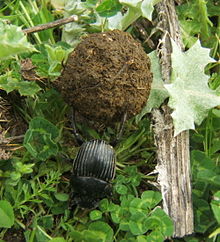- Dung beetle
-
This article is about the beetle. For the characters in the Conker series, see List of characters in the Conker series#Dung Beetles."Dung Beetles" redirects here. For the computer game, see Dung Beetles (computer game).
Dung Beetle 
Scarabaeus viettei (syn. Madateuchus viettei, Scarabaeidae); picture taken in dry spiny forest close to Mangily, western Madagascar Scientific classification Kingdom: Animalia Phylum: Arthropoda Class: Insecta Order: Coleoptera Superfamily: Scarabaeoidea Dung beetles are beetles that feed partly or exclusively on feces. All of these species belong to the superfamily Scarabaeoidea; most of them to the subfamilies Scarabaeinae and Aphodiinae of the family Scarabaeidae. This beetle can also be referred to as the scarab beetle. As most species of Scarabaeinae feed exclusively on feces, that subfamily is often dubbed true dung beetles. There are dung-feeding beetles which belong to other families, such as the Geotrupidae (the earth-boring dung beetle). The Scarabaeinae alone comprises more than 5,000 species.[1]
Many dung beetles, known as rollers, are noted for rolling dung into spherical balls, which are used as a food source or brooding chambers. Other dung beetles, known as tunnelers, bury the dung wherever they find it. A third group, the dwellers, neither roll nor burrow: they simply live in manure. They are often attracted by the dung burrowing owls collect.
Contents
Ecology and behavior
Dung beetles live in many different habitats, including desert, farmland, forest, and grasslands. They do not prefer extremely cold or dry weather. They are found on all continents except Antarctica.
Dung beetles eat dung excreted by herbivores and omnivores, and prefer that produced by the former. Many of them also feed on mushrooms and decaying leaves and fruits. One type living in South America, Deltochilum valgum, is a carnivore preying upon millipedes. Those that eat dung do not need to eat or drink anything else, because the dung provides all the necessary nutrients.
Most dung beetles search for dung using their sensitive sense of smell. Some of the smaller species simply attach themselves to the dung-providers to wait for their reward. After capturing the dung, a dung beetle will roll it, following a straight line despite all obstacles. Sometimes dung beetles will try to steal the dung ball from another beetle, so the dung beetles have to move rapidly away from a dung pile once they have rolled their ball to prevent it from being stolen. Dung beetles can roll up to 50 times their weight. Male Onthophagus taurus beetles can pull 1,141 times their own body weight: the equivalent of an average person pulling six double-decker buses full of people.[2] In 2003, researchers found one species of dung beetle (the African Scarabaeus zambesianus) navigates by using polarization patterns in moonlight. The discovery is the first proof any animal can use polarized moonlight for orientation.[3][4][5]
The "rollers" roll and bury a dung ball either for food storage or for making a brooding ball. In the latter case, two beetles, one male and one female, will be seen around the dung ball during the rolling process. Usually it is the male that rolls the ball, with the female hitch-hiking or simply following behind. In some cases the male and the female roll together. When a spot with soft soil is found, they stop and bury the dung ball. They will then mate underground. After the mating, both or one of them will prepare the brooding ball. When the ball is finished, the female lays eggs inside it, a form of mass provisioning. Some species do not leave after this stage, but remain to safeguard their offspring.
The dung beetle goes through a complete metamorphosis. The larvae live in brood balls made with dung prepared by their parents. During the larval stage, the beetle feeds on the dung surrounding it.
The behavior of the beetles was much misunderstood until the pioneering studies of Jean Henri Fabre. For example, Fabre corrected the myth that a dung beetle would seek aid from other dung beetles when confronted by obstacles. By painstaking observations and experiments, he found the seeming helpers were, in fact, robbers awaiting an opportunity to steal the roller's food source:
“ I ask myself in vain what Proudhon introduced into Scarabaean morality the daring paradox that "property means plunder", or what diplomatist taught the Dung-beetle the savage maxim that "might is right".[6] ” Benefits and uses
Dung beetles play a remarkable role in agriculture. By burying and consuming dung, they improve nutrient recycling and soil[7] structure. They also protect livestock, such as cattle, by removing the dung which, if left, could provide habitat for pests such as flies. Therefore, many countries have introduced the creature for the benefit of animal husbandry. In developing countries, the beetle is especially important as an adjunct for improving standards of hygiene. The American Institute of Biological Sciences reports that dung beetles save the United States cattle industry an estimated US$380 million annually through burying above-ground livestock faeces.[8]
In Australia, the Commonwealth Scientific and Industrial Research Organisation (CSIRO) commissioned the Australian Dung Beetle Project (1965-1985) which, led by Dr. George Bornemissza, sought to introduce species of dung beetles from South Africa and Europe. The successful introduction of 23 species was made, most notably Onthophagus gazella and Euoniticellus intermedius, which have resulted in the improvement of the quality and fertility of Australian cattle pastures, along with a reduction in the population of pestilent bush flies by around 90 percent.[9]
An application has been made by Landcare Research to import up to 11 species of dung beetle into New Zealand.[10] As well as improving pasture soils the Dung Beetle Release Strategy Group say that it result in a reduction in greenhouse gas emissions from the agricultural sector.[11]
Like many other insects, the (dried) dung beetle, called qianglang (蜣蜋) in Chinese, is used in Chinese herbal medicine. It is recorded in the "Insect section" (蟲部) of the Compendium of Materia Medica, where it is recommended for the cure of 10 diseases.
Scarab in Ancient Egypt
Main article: Scarab (artifact) A scarab statue at the Karnak temple complex
A scarab statue at the Karnak temple complex
Several species of the dung beetle, most notably the species Scarabaeus sacer (often referred to as the sacred scarab), enjoyed a sacred status among the ancient Egyptians.
![L1 [xpr] xpr](/pictures/enwiki/50/220px-Egypt.KV6.04.jpg)
ḫpr
in hieroglyphsPopular interpretation in modern academia theorizes the hieroglyphic image of the beetle represents a triliteral phonetic that Egyptologists transliterate as xpr or ḫpr and translate as "to come into being", "to become" or "to transform". The derivative term xprw or ḫpr(w) is variously translated as "form", "transformation", "happening", "mode of being" or "what has come into being", depending on the context. It may have existential, fictional, or ontologic significance.
The scarab was linked to Khepri ("he who has come into being"), the god of the rising sun. The ancients believed that the dung beetle was only male in gender, and reproduced by depositing semen into a dung ball. The supposed self-creation of the beetle resembles that of Khepri, who creates himself out of nothing. Moreover, the dung ball rolled by a dung beetle resembles the sun. Plutarch wrote:
“ The race of beetles has no female, but all the males eject their sperm into a round pellet of material which they roll up by pushing it from the opposite side, just as the sun seems to turn the heavens in the direction opposite to its own course, which is from west to east."[12] ” The ancient Egyptians believed that Khepri renewed the sun every day before rolling it above the horizon, then carried it through the other world after sunset, only to renew it, again, the next day. Some New Kingdom royal tombs exhibit a threefold image of the sun god, with the beetle as symbol of the morning sun. The astronomical ceiling in the tomb of Ramses VI portrays the nightly "death" and "rebirth" of the sun as being swallowed by Nut, goddess of the sky, and re-emerging from her womb as Khepri.
The image of the scarab, conveying ideas of transformation, renewal, and resurrection, is ubiquitous in ancient Egyptian religious and funerary art.
Excavations of ancient Egyptian sites have yielded images of the scarab in bone, ivory, stone, Egyptian faience, and precious metals, dating from the Sixth Dynasty and up to the period of Roman rule. They are generally small, bored to allow stringing on a necklace, and the base bears a brief inscription or cartouche. Some have been used as seals. Pharaohs sometimes commissioned the manufacture of larger images with lengthy inscriptions, such as the commemorative scarab of Queen Tiye. Massive sculptures of scarabs can be seen at Luxor Temple, at the Serapeum in Alexandria (see Serapis) and elsewhere in Egypt.
The scarab was of prime significance in the funerary cult of ancient Egypt. Scarabs, generally, though not always, were cut from green stone, and placed on the chest of the deceased. Perhaps the most famous example of such "heart scarabs" is the yellow-green pectoral scarab found among the entombed provisions of Tutankhamen. It was carved from a large piece of Libyan desert glass. The purpose of the "heart scarab" was to ensure that the heart would not bear witness against the deceased at judgement in the Afterlife. Other possibilities are suggested by the "transformation spells" of the Coffin Texts, which affirm that the soul of the deceased may transform (xpr) into a human being, a god, or a bird and reappear in the world of the living.
One scholar comments on other traits of the scarab connected with the theme of death and rebirth:
“ It may not have gone unnoticed that the pupa, whose wings and legs are encased at this stage of development, is very mummy-like. It has even been pointed out that the egg-bearing ball of dung is created in an underground chamber which is reached by a vertical shaft and horizontal passage curiously reminiscent of Old Kingdom mastaba tombs."[13] ” In contrast to funerary contexts, some of ancient Egypt's neighbors adopted the scarab motif for seals of varying types. The best-known of these being Judean LMLK seals (8 of 21 designs contained scarab beetles), which were used exclusively to stamp impressions on storage jars during the reign of Hezekiah.
The scarab remains an item of popular interest thanks to modern fascination with the art and beliefs of ancient Egypt. Scarab beads in semiprecious stones or glazed ceramics can be purchased at most bead shops, while at Luxor Temple a massive ancient scarab has been roped off to discourage visitors from rubbing the base of the statue "for luck".
In literature
In Aesop's fable "The Dung Beetle and the Eagle", the eagle kills a hare despite the beetle's appeals. The beetle takes revenge by twice destroying the eagle's eggs. The eagle, in despair, flies up to Olympus and places her latest eggs in Zeus's lap, beseeching the god to protect them. When the beetle finds out what the eagle has done, it stuffs itself with dung, goes straight up to Zeus and flies right into his face. Zeus is startled at the sight of the unpleasant creature and jumps to his feet. The eggs are broken. Zeus then learns of the beetle's plea which the eagle had ignored. He scolds the eagle and urges the beetle to stay away from the bird. But his efforts to persuade the beetle fail; so he changes the breeding season of the eagles to take place at a time when the beetles are not above ground.
Aristophanes alluded to Aesop's fable several times in his plays. In Peace, the hero rides up to Olympus to free the goddess Peace from her prison. His steed is an enormous dung beetle which has been fed so much dung that it has grown to monstrous size.
In Franz Kafka's The Metamorphosis, the transformed character of Gregor Samsa is called an "old dung beetle" (alter Mistkäfer) by the charwoman.
The inadvertent theft of a prized scarab forms the backdrop to Something Fresh, the first of the celebrated Blandings Castle novels of P.G. Wodehouse.
In Richard Marsh's gothic novel The Beetle: A Mystery (1987),a beetle with supernatural powers comes to England to haunt politician Paul Lessingham.
See also Edgar Allan Poe's "The Gold-Bug".
See also
- Catharsius, an important dung beetle genus in African and Asian environments
- Addo Elephant National Park, site of the largest remaining population of the endangered flightless dung beetle (Circellium bacchus).
- List of dung beetle and chafer (Scarabaeoidea) species recorded in Britain
- Rotating locomotion in living systems
References
- ^ Frolov, A.V.. "Subfamily Scarabaeinae: atlas of representatives of the tribes (Scarabaeidae)". Retrieved on 2007-08-02.
- ^ [1]
- ^ Dacke, Marie, Dan-Eric Nilsson, Clarke H. Scholtz, Marcus Byrne and Eric J. Warrant (2003). "Animal behaviour: Insect orientation to polarized moonlight". Nature 424(6944):33.
- ^ Milius, Susan (2003). "Moonlighting: Beetles navigate by lunar polarity". Science News 164(1):4.
- ^ Roach, John (2003). "Dung Beetles Navigate by the Moon, Study Says", National Geographic News. Retrieved on 2007-08-02.
- ^ J. Henri Fabre (1949). The Insect World of J. Henri Fabre. Trans. by Alexander Teixeira de Mattos; introduced by Edwin Way Teale. New York: Dodd, Mead & Company. Page 99.
- ^ Brown, J., Scholtz, C.H., Janeau, J-L., Grellier, S. and Podwojewski, P. 2010. Dung beetles (Coleoptera: Scarabaeidae) can improve soil hydrological properties. Applied Soil Ecology 46: 9-16
- ^ Losey, John E. and Mace Vaughan (2006). "The Economic Value of Ecological Services Provided by Insects". BioScience 56(4):311-323.
- ^ Bornemissza, G. F. (1976), The Australian dung beetle project 1965-1975, Australian Meat Research Committee Review 30:1-30
- ^ "Application summary - ERMA200599". ERMA. http://www.ermanz.govt.nz/BertDocs/ERMA200599_Application%20summary%20ERMA200599%20FINAL.pdf. Retrieved 12 December 2010.
- ^ Ihaka, James (24 September 2010). "Let's roll... dung beetle to combat global warming". The New Zealand Herald. http://www.nzherald.co.nz/nz/news/article.cfm?c_id=1&objectid=10675713. Retrieved 12 December 2010.
- ^ "Isis and Osiris", Moralia, in volume V of the Loeb Classical Library edition, 1936, now in the public domain. Retrieved on 2007-08-02.
- ^ Andrews, Carol (1994). Amulets of Ancient Egypt. Texas: University of Texas Press. ISBN 0-292-70464-X. Page 51.
Further reading
- Buchberger, Hannes (1993). Transformation und Transformat. Sargtextstudien I. Wiesbaden: Harrassowitz Verlag. ISBN 3-447-03078-X.
- Cambefort, Yves (1994). Le scarabee et les dieux. Essai sur la signification symbolique et mythique des coleopteres. Paris: Editions Boubee. ISBN 2-85004-079-7.
- Cooney, K.M. and Johnna Tyrrell (2005). "Scarabs in the Los Angeles County Museum of Art".PalArch's Journal of Archaeology of Egypt/Egyptology 4(1-3):1-98.
- Faulkner, Raymond O. (2002). A Concise Dictionary of Middle Egyptian. Oxford: Griffith Institute. ISBN 0-900416-32-7.
- Halffter, Gonzalo and Eric G. Matthews (1966). "The Natural History of Dung Beetles: Of the Subfamily Scarabaeinae". Folia Entomológica Mexicana 12-14:1-312 (rpt. Palermo: Medical Books, 1999).
- Hanski, Ilkka and Yves Cambefort (ed.s) (1991). Dung Beetle Ecology. Princeton: Princeton University Press. ISBN 0-691-08739-3.
- Imamori, Mitsuhiko (1991). [Sacred Dung Beetles (in Japanese)]. Tokio: Heibon-sha (with a chapter on Egyptian scarabs by Y. Cambefort). ISBN 4-582-52928-3.
- Taylor, John H. (2004). Mummy: The Inside Story. London: British Museum Press. ISBN 0-7141-1962-8.
- Wilkinson, Richard H. (1994). Symbol & Magic in Egyptian Art. London: Thames and Hudson. ISBN 0-500-23663-1.
- Connor Hillo, The scarab is the symbol of Re, the sun god of Egypt. The Egyptians thought that the dung ball was equated to the sun in the sky (while rolling).
- Jill Aisthorpe, Department of Primary Industries and Fisheries, Queensland government, and Penny Edwards, Dung beetles – biology and life cycles
External links
- Beetles as religious symbols at insects.org
- Scarabaeinae Research Network, "an international group of dung beetle taxonomists, ecologists and systematists working together to establish scarabaeine dung beetles as an invertebrate focal taxon for biodiversity study and conservation"
- Dung beetles at the Australia Museum
- Catharsius, an international group of specialists working on taxonomy and ecology of Western African dung beetles
- Tomas Libich, Congo dung beetle sp1 and Congo dung beetle sp2 photos
- Dung Beetles in action (video) by The WILD Foundation/Boyd Norton
Categories:- Coprophagous animals
- Scarabaeinae
- Scarabaeidae
- Egyptian artefact types
- Egyptian hieroglyphs
Wikimedia Foundation. 2010.


